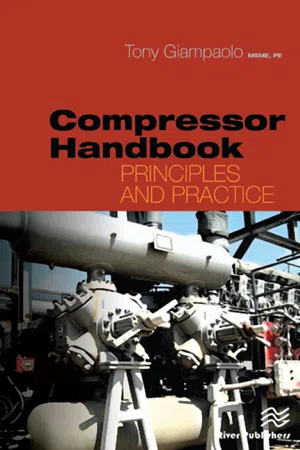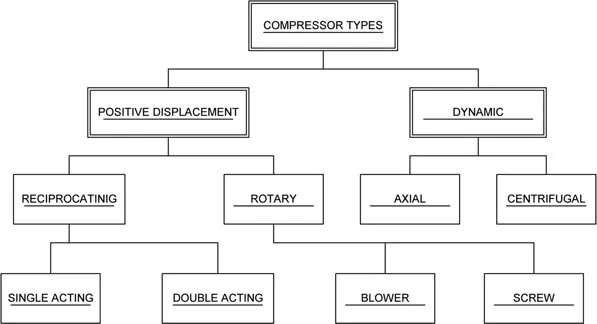
eBook - ePub
Compressor Handbook
Principles and Practice
Anthony Giampaolo
This is a test
Compartir libro
- 300 páginas
- English
- ePUB (apto para móviles)
- Disponible en iOS y Android
eBook - ePub
Compressor Handbook
Principles and Practice
Anthony Giampaolo
Detalles del libro
Vista previa del libro
Índice
Citas
Información del libro
This book provides a practical introduction to dynamic and positive displacement compressors, including compressor performance, operation, and problem awareness. In reading this book readers will learn what is needed to select, operate, and troubleshoot compressors.Complete with real-lifecase histories, the book demonstrates investigative techniques foridentifying and isolatingvarious contributing causes, includingdesign deficiencies, manufacturing defects, adverse environmental conditions, operating errors, and intentional or unintentional changes of the machinery process that usually precedefailure.
Preguntas frecuentes
¿Cómo cancelo mi suscripción?
¿Cómo descargo los libros?
Por el momento, todos nuestros libros ePub adaptables a dispositivos móviles se pueden descargar a través de la aplicación. La mayor parte de nuestros PDF también se puede descargar y ya estamos trabajando para que el resto también sea descargable. Obtén más información aquí.
¿En qué se diferencian los planes de precios?
Ambos planes te permiten acceder por completo a la biblioteca y a todas las funciones de Perlego. Las únicas diferencias son el precio y el período de suscripción: con el plan anual ahorrarás en torno a un 30 % en comparación con 12 meses de un plan mensual.
¿Qué es Perlego?
Somos un servicio de suscripción de libros de texto en línea que te permite acceder a toda una biblioteca en línea por menos de lo que cuesta un libro al mes. Con más de un millón de libros sobre más de 1000 categorías, ¡tenemos todo lo que necesitas! Obtén más información aquí.
¿Perlego ofrece la función de texto a voz?
Busca el símbolo de lectura en voz alta en tu próximo libro para ver si puedes escucharlo. La herramienta de lectura en voz alta lee el texto en voz alta por ti, resaltando el texto a medida que se lee. Puedes pausarla, acelerarla y ralentizarla. Obtén más información aquí.
¿Es Compressor Handbook un PDF/ePUB en línea?
Sí, puedes acceder a Compressor Handbook de Anthony Giampaolo en formato PDF o ePUB, así como a otros libros populares de Scienze fisiche y Termodinamica. Tenemos más de un millón de libros disponibles en nuestro catálogo para que explores.
Información
Chapter 1
Introduction
HISTORY
The history of compressors is as varied as are the different types of compressors. Therefore it is fitting that we first identify the different types of compressors. As shown in Chart 1-1, compressors fall into two separate and distinct categories: dynamic and positive displacement.

Somewhere in antiquity the bellows was developed to increase flow into a furnace in order to stoke or increase furnace heat. This was necessary to smelt ores of copper, tin, lead and iron. This led the way to numerous other inventions of tools and weapons.
One of the earliest recorded uses of compressed gas (air) dates back to 3rd century B.C. This early use of compressed air was the “water organ.” The invention of the “water organ” is commonly credited to Ctesibius of Alexandria1. The concept was further improved by Hero of Alexandria (also noted for describing the principles of expanding steam to convert steam power to shaft power).
The water organ consisted of a water pump, a chamber partly filled with air and water, a row of pipes on top (organ pipes) of various diameters and lengths plus connecting tubing and valves. By pumping water into the water/air chamber the air becomes compressed. Than by opening valves to specific organ pipes the desired musical sound is created.
Ctesibius also developed the positive displacement cylinder and piston to move water.
It was not until the late 19th century that many of these ideas were turned into working hardware.
In the 1850s, while trying to find a replacement for the water wheel at their family’s woolen mill, Philander and Francis Roots devised what has come to be known as the Roots blower3. Their design consisted of a pair of figure-eight impellers rotating in opposite directions. While some Europeans were simultaneously experimenting with this design, the Roots brothers perfected the design and put it into large-scale production.

It is not surprising that other compressor designs followed power-producing designs. For example, the reciprocating engine concept easily transfers to the reciprocating compressor.


The integral-engine-compressor is a good example as its design utilizes one main shaft connected to both the power cylinders and the compression cylinders. The form and function of the compressor cylinders are the same whether it is configured as an integral engine-compressor or a separable-compressor driven by an electric motor, gas engine or turbine.
Other examples are the centrifugal compressor, (Figure 1-4) the turbo-expander, the axial compressor, and the axial turbine (Figure 1-5 and 1-6).
In 1808 John Dumball envisioned a multi-stage axial compressor. Unfortunately his idea consisted only of moving blades without stationary airfoils to turn the flow into each succeeding stage.4,5,6
Not until 1872 did Dr. Franz Stolze combine the ideas of John Barber and John Dumball to develop the first axial compressor driven by an axial turbine. Due to a lack of funds, he did not build his machine until 1900. Dr. Stolze’s design consisted of a multi-stage axial flow compressor, a single combustion chamber, a multi-stage axial turbine, and a regenerator utilizing exhaust gases to heat the compressor discharge gas. This unit was tested between 1900 and 1904, but never ran successfully.


Operating conditions have a significant impact on compressor selection and compressor performance. The influences of pressure, temperature, molecular weight, specific heat ratio, compression ratio, speed, vane position, volume bottles, loaders and unloaders, etc. are addressed in this book. These conditions impact compressor capacity and therefore the compressor selection. They also impact the compressor efficiency. Flexibility in selection is still possible to some extent as compressors can be operated in parallel and series modes. For example, to achieve higher pressures multiple compressors can be configured in series whereby the discharge of one compressor feeds directly into the suction of a second compressor, etc. Likewise, to achieve higher flows multiple compressors can be configured in parallel whereby the suction of each compressor is manifolded together and the discharge of each compressor is also manifolded together.

Different methods of throughput control are addressed in Chapter 5, such as, discharge throttling, suction throttling, guide vane positioning, volume bottles, suction valve unloaders and speed control; and how each of these control methods effects compressor life.
This book discusses different compressors; how they operate and how they are controlled. Since the cost of process downtime and damage to a compressor can range from thousands to millions of dollars; the types of failures that can occur and how to avoid these failures is also addressed in this book.
In view of the fact that the most destructive event in a dynamic compressor is surge, compressor surge will be defined and discussed in detail. Also discussed are the various types of instrumentation (controllers, valves, pressure and temperature transmitters, etc..) available and which are most suitable in controlling surge. Destructive modes of other compressors are also addressed.
A few algorithms are presented, primarily in Chapters 4 and 7, to help demonstrate interactions of pressure, temperature and quantify results, but their understanding is not essential to the selection of the proper control scheme and instrumentation. The reader should not be intimidated by these algorithms as their understanding will open up a broader appreciation of how the compressor works.
Footnotes
1 A History of Mechanical Inventions, Abbott Payton Usher. This Dover edit...